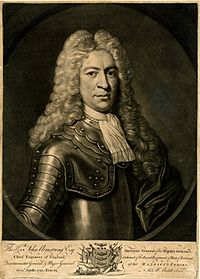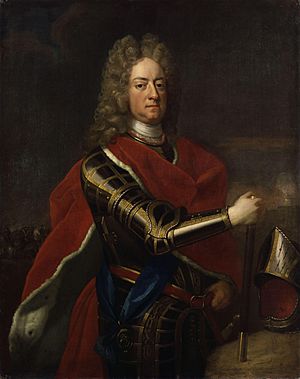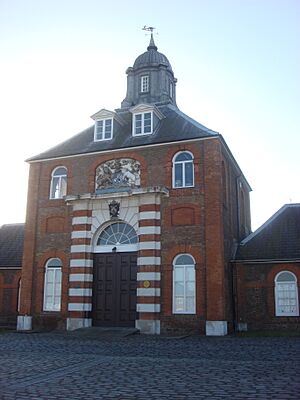John Armstrong (British Army officer) facts for kids
Quick facts for kids
Major-General John Armstrong
|
|
|---|---|

Major-General John Armstrong, Chief Royal Engineer
|
|
| Born | 31 March 1674 Ballyan, County Offaly |
| Died | 15 April 1742 (aged 68) Tower of London |
| Buried |
Church of St Peter ad Vincula, London
|
| Allegiance | |
| Service/ |
British Army |
| Years of service | 1691 to 1741 |
| Rank | Major-General, July 1739 |
| Unit | Colonel, Royal Regiment of Ireland 1735–1742 |
| Commands held | Chief Royal Engineer 1714–1742; Surveyor-General of the Ordnance 1722–1742; |
| Battles/wars | Williamite War in Ireland 1689–1691 Nine Years War 1689–1697 War of the Spanish Succession 1701–1714 Cadiz 1702 Battle of Blenheim 1704 Siege of Bouchain 1711 |
| Other work | Fellow of the Royal Society 1723 |
Major-General John Armstrong (born March 31, 1674 – died April 15, 1742) was a skilled British military engineer and soldier. He held important roles like Chief Royal Engineer and Surveyor-General of the Ordnance.
He also played a big part in creating the Royal Military Academy, Woolwich. This academy was a special training school for engineers.
Contents
Life of John Armstrong
John Armstrong was born on March 31, 1674. His birthplace was a village called Ballyan in what is now County Offaly, Ireland. He was the oldest son of Robert and Lydia Armstrong.
He had two sisters, Lydia and Elizabeth. His brothers, Samuel and Michael, also joined the army.
In 1710, John Armstrong married Anna Burroughs. They had five daughters: Lydia, Anne, Frances, Mary, and Priscilla.
Armstrong's Military Career

In 1688, a big event called the Glorious Revolution happened in Britain. King James II went into exile. To try and get his kingdoms back, he landed in Ireland in 1689. This started the Williamite War in Ireland.
In 1691, Armstrong joined the army that supported William III. He was part of the Duke of Ormonde's Horse Guards. He was captured by the other side but was released when the war ended in October 1691.
After the war, in 1695, he joined another army group. This was his relative Philip Armstrong's troop. It was part of Wood's Regiment of Horse.
Serving in Major Wars
The Nine Years War ended in 1697. After this, Armstrong's regiment returned to England.
Later, the War of the Spanish Succession began. Armstrong served in a battle at Cadiz in 1702. He was under the command of the Duke of Ormonde.
Ormonde recommended him to Holcroft Blood, who was the chief engineer for Marlborough. Armstrong then served in the Flanders campaign. This included the famous Blenheim in 1704. He also took part in the Siege of Bouchain in 1711.
He worked closely with another engineer, Thomas Lascelles. They remained good friends and colleagues for many years. Armstrong kept his positions even during political changes. He became Quartermaster-General to the Forces just before the war ended in 1713.
Work at Dunkirk
The peace treaty after the war had an important rule. France had to destroy the forts and block the port of Dunkirk. Dunkirk was a big base for privateers. These were ships that attacked British merchant ships.
It was easy for them to reach the North Sea from Dunkirk. This made it hard for the Royal Navy to catch them. So, destroying Dunkirk was very important for British trade.
In September 1713, Armstrong and Thomas Lascelles were chosen to watch over this work. They made sure the port was properly destroyed.
Changes in the Ordnance Service
In 1714, George I became king. Marlborough was put back in charge of the Ordnance. He started many improvements.
Armstrong became the Chief Royal Engineer. In 1716, the Ordnance Service was split into two parts: artillery and engineers. These later became the Royal Engineers and the Royal Artillery.
In May 1716, Armstrong was at a place called The Foundery. He was watching French cannons being melted down. Suddenly, there was a huge explosion. Seventeen people died, but Armstrong was one of the few who were not hurt. This accident led to the creation of the Royal Arsenal in Woolwich.
Later Life and Achievements
Armstrong returned to England in 1718. Lascelles took over the work at Dunkirk. Besides his official duties, Armstrong was involved in many other things.
In May 1723, he became a Fellow of the Royal Society. This is a group of important scientists. He also suggested ways to make the port at King's Lynn better.
In the 1720s, he designed and built a lake at Blenheim Palace. He was very involved in setting up the Royal Arsenal and the Royal Military Academy, Woolwich.
From 1735 to 1742, he was the Colonel of the Royal Regiment of Ireland. In 1739, he was promoted to Major-General.
In late 1741, he became ill at his office in the Tower of London. He died there on April 15, 1742. He was buried in the chapel at the Tower, called the Church of St Peter ad Vincula.
| Military offices | ||
|---|---|---|
| Preceded by New Post |
Quartermaster-General to the Forces 1712–1742 |
Succeeded by Humphrey Bland |
| Preceded by Michael Richards |
Chief Royal Engineer 1714–1742 |
Succeeded by Thomas Lascelles |
| Surveyor-General of the Ordnance 1722–1742 |
||
| Preceded by Sir Charles Hotham, 5th Baronet |
Colonel of the Royal Regiment of Ireland 1735–1742 |
Succeeded by John Mordaunt |


